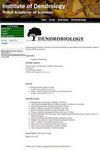The oil content and fatty acid composition of Fagus orientalis Lipsky seeds from different populations in Turkiye
IF 1.8
4区 农林科学
Q2 FORESTRY
引用次数: 0
Abstract
Knowledge of the nutrient content of edible seeds of oriental beech (Fagus orientalis Lipsky) as a food resource for rural people, is incomplete and there is a need for studies that will provide this information. The seeds of oriental beech collected from 12 different locations in a primary distribution area of Turkey were investigated for their oil content and fatty acid composition. The fatty acid contents of these 12 different populations were determined by gas chromatography-mass spectrometry (GC/MS) of the fatty acids methyl esters (FAME). The seeds of the various tree populations were found to contain total oil amount ranging from 44.66% to 49.07%, which was primarily composed of oleic, linoleic, palmitic, and gadoleic acids. As the predominant unsaturated fatty acid, there was no difference among the populations in the percentage of oleic acid with the highest percentage of unsaturated fatty acids. As the primary saturated fatty acid, the highest palmitic acid content was determined in the Ordu-Akkuş population (13.85%), where the species made the optimal development, while the lowest value was determined in the Kahramanmaraş-Andırın population (7.14%), which is an isolated population of the species. In the study of oriental beech populations, palmitic acid was found in the major saturated fatty acids, on the other hand oleic, linoleic, and gadoleic acids were found in major unsaturated fatty acids. This study highlights the potential of oriental beech seeds as a nutrient-rich food source due to their high total fat content.土耳其不同群体东方法格斯种子的含油量和脂肪酸组成
关于东方山毛榉(Fagus orientalis Lipsky)可食用种子作为农村人的食物资源的营养成分的知识还不完整,需要进行研究来提供这些信息。对从土耳其主要分布区12个不同地点采集的东方山毛榉种子的含油量和脂肪酸组成进行了研究。通过脂肪酸甲酯(FAME)的气相色谱-质谱(GC/MS)测定了这12个不同群体的脂肪酸含量。不同树种的种子含油量在44.66%至49.07%之间,主要由油酸、亚油酸、棕榈酸和钆酸组成。油酸作为主要的不饱和脂肪酸,其不饱和脂肪含量最高,各群体之间的油酸含量没有差异。作为初级饱和脂肪酸,棕榈酸含量最高的是该物种发育最佳的Ordu Akkuş种群(13.85%),而最低的值是该物种的孤立种群Kahramanmaraş-Andırın种群(7.14%)。在对东方山毛榉种群的研究中,棕榈酸存在于主要的饱和脂肪酸中,而油酸、亚油酸和钆酸存在于重要的不饱和脂肪酸。这项研究强调了东方山毛榉种子作为营养丰富的食物来源的潜力,因为它们的总脂肪含量很高。
本文章由计算机程序翻译,如有差异,请以英文原文为准。
求助全文
约1分钟内获得全文
求助全文
来源期刊

Dendrobiology
农林科学-林学
CiteScore
2.20
自引率
11.10%
发文量
17
审稿时长
>12 weeks
期刊介绍:
Dendrobiology publishes original research articles and review articles related to the biology of trees and shrubs.
 求助内容:
求助内容: 应助结果提醒方式:
应助结果提醒方式:


